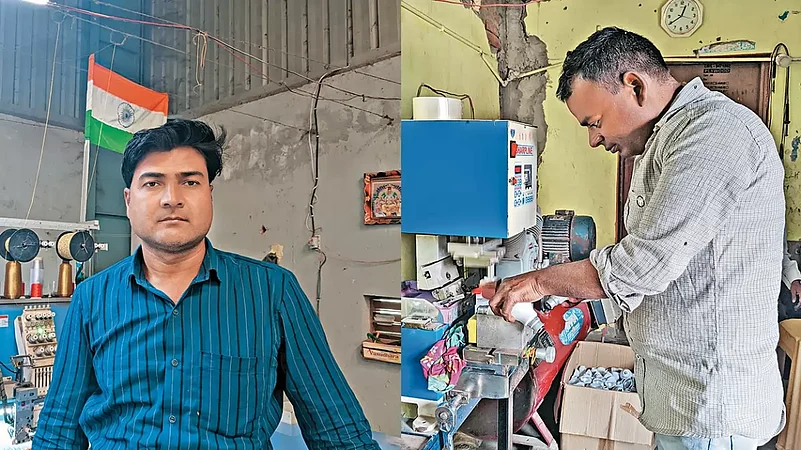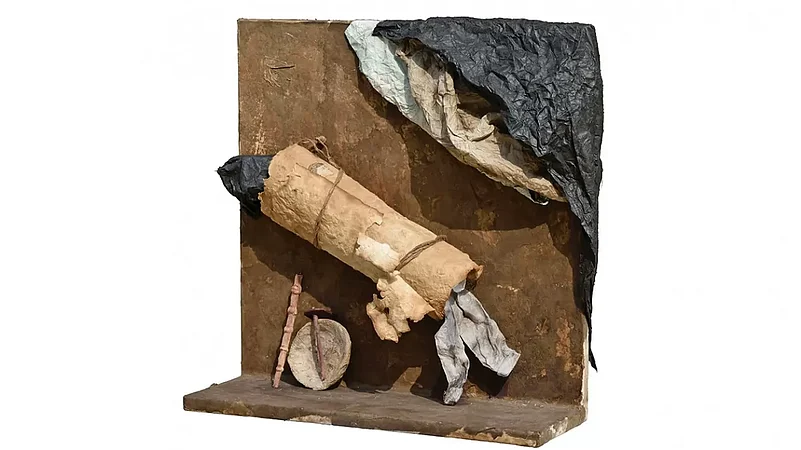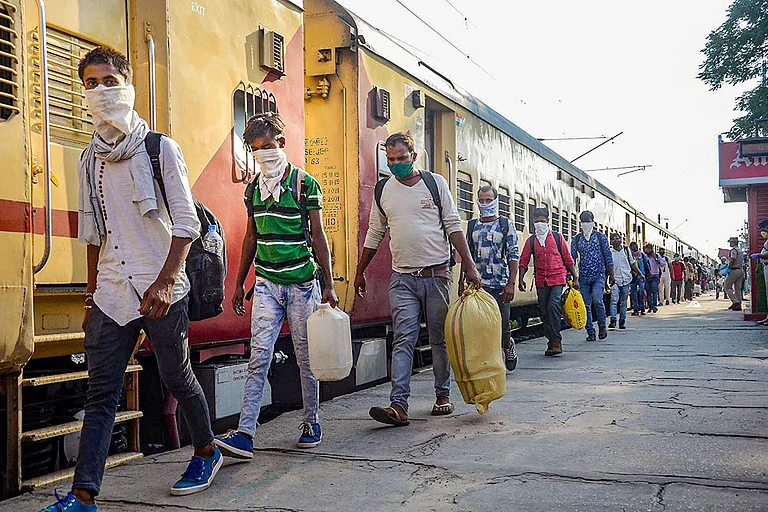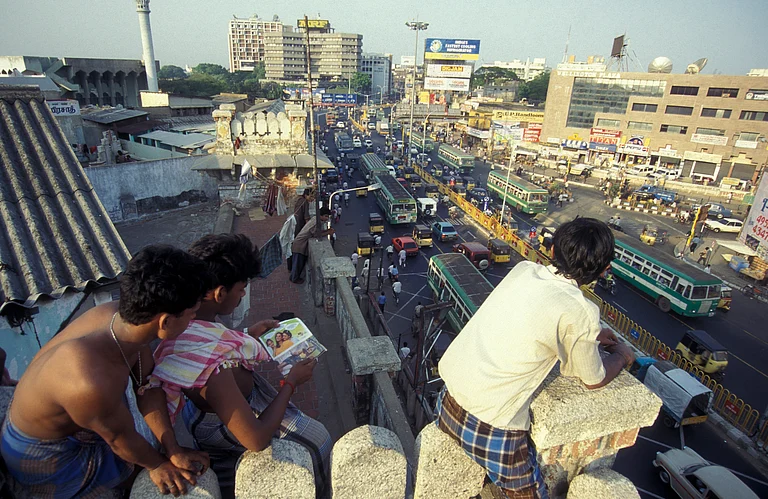In 2020, in the first week of March, Mukesh Paswan, 35, a resident of Nalanda district in Bihar, returned to Greater Noida after celebrating Holi with his family. Paswan worked as a tailor at a clothes manufacturing factory and earned Rs 15,000 a month. Just two weeks after he returned, a nationwide lockdown was announced.
There was no work. Paswan ran out of cash to buy ration, so his family sent him Rs 8,000. In April-end, he decided to return to Nalanda, but there were no buses or trains. Thirty workers from his home state, who were also working in and around Noida, decided to hire a truck that would take them home. The driver charged Rs 3,000 per person.
It took four days to reach home in a CNG truck. Upon returning, he spent two weeks in a government school, which was turned into a quarantine centre. “To ensure the safety of my family, I slept on a cot beneath a banyan tree for another week,” says Paswan.
There was a lot of uncertainty and Paswan was beginning to get worried about his future.
In the first week of May that year, an announcement made by Chief Minister Nitish Kumar gave hope to Paswan and lakhs of migrant labourers who were forced to return home during the lockdown.
Reverse Migration And Skill Mapping
The government announced that it would map the skillsets of those who had returned and would provide them with employment opportunities in their respective villages or panchayats based on their skills so that they didn’t have to migrate again, leaving their families behind.
The state government was gearing up to deal with lakhs of migrant workers who were returning home in special trains run by the central government from May 1. As per an advertisement issued by the state disaster management department in local dailies, 9.18 lakh migrant labourers were expected to return to Bihar by the end of May 2020. These were official numbers. Unofficially, many like Paswan had returned in trucks, buses, lorries, cycles or on foot and would continue to return over the next few weeks.
Initially, the chief minister was reluctant to bring back those from Bihar stranded elsewhere, stating it as “an injustice to the principle of the lockdown.” A few weeks later, Bihar became the first state to announce skill mapping of returning migrant labourers for employment generation.
Shyam Rajak, who served as the Minister for Industries during the lockdown, announced the state would form advisory centres in every district to provide employment to migrant workers. Vijay Kumar Sinha, minister, Labour Resource Department, promised to provide training to migrant workers to enhance their employability.
Migrants were categorised as unskilled, semi-skilled and skilled. About 16 lakh migrant labourers were mapped as skilled and included construction workers (8.40 lakh), tailors (57,000), carpenters (41,000), processing workers (4,000) and handicraft workers (1,400).
“I remember when I was in quarantine, a few officials visited the centre. I told them about my two-decade-long tailoring experience,” says Paswan, a father of three young children.
He waited for a month but got no job. The family ran out of their savings and even buying everyday rations was a struggle. Paswan returned to Greater Noida. Once the factory reopened, Paswan realised his shift hours were now longer than before, but his income had reduced by 40 percent. Eventually, Paswan moved to Tamil Nadu and is now working at a rice mill.
Kailash Ravidas, a resident of Nawadih village in Jamui district, was promised work in his home district by the chief minister himself through video conferencing when he was quarantined. However, no government officials called him. He returned to Kolkata where he worked as a cobbler.
“I am handicapped. I have limitations. If the government had provided me with a small loan, I would have opened a shop in my village and sold shoes and slippers,” he says.
Despite the massive skill-mapping exercise, what made Paswan, Ravidas and many others return to big cities for work?
“Improper Execution”
Nawal Kishore Chaudhary, an economist and a senior professor at Patna University, feels the skill-mapping exercise was a political stunt as assembly elections were due in the state.
“It was a smart move, but the government did not execute it properly. It would have certainly benefitted the migrant labourers,” says Dr Awadhesh Kumar, the Head of Department and Assistant Professor at the Division of Economics at the AN Sinha Institute of Social Studies, Patna.
DM Diwakar, a Patna-based economist, says the Bihar government did an incomplete skill mapping, that too half-heartedly. “I had suggested a single window clearance system at the district level so that the migrants could start small-scale businesses. But that was not done,” he says.
Chaudhary feels the government did little to generate employment, which forced people to start moving out again.
In the absence of data, it is not known how many migrant labourers actually got jobs. When contacted, Rajak says: “We had provided employment in every district and given loans for start-ups. But I don’t have the numbers.”
The Department of Industries and the Labour Resource Department did not have any data either. “I have no idea about any skill mapping and whether work was given to migrant workers,” says a senior official.
Poverty And Migration
With over 50 percent of the population in the state identified as “multidimensionally poor”, Bihar has the maximum percentage of population living in poverty among all the states, according to NITI Aayog’s Multidimensional Poverty Index released in 2021. A majority of the state’s population is forced to depend on agriculture because of lack of industries and formal employment opportunities. Many are forced to look for work outside the state. Estimates made with the help of the 2011 Census, the National Sample Survey (NSS) and the economic survey put the total number of interstate migrants in India at 6.5 crore, of which 33% are workers. Bihar accounts for 14%.
An article titled ‘Outmigration from Bihar: Causes and Consequences’ (2012), published in the Journal of Social and Economic Studies, states: “This region started to experience labour out-migration at the earliest. This phenomenon is largely attributed to the pattern of regional inequality and underdevelopment fostered in the colonial period.” The article notes the tradition of migration is not only continuing but it has increased drastically and now migration for livelihood is happening across the hierarchy of caste and class of the state.
Out of 1.23 crore migrant workers who returned to their home states during the lockdown, 50 percent (61,34,943) were from Uttar Pradesh, Bihar and West Bengal, the Ministry of Labour and Employment informed the Lok Sabha in 2021. The data shows out of this 50 percent, 12 percent were from Bihar.
However, the lack of data makes it difficult to assess how many migrants ended up staying back in the state after the skill-mapping exercise.
A Push from the Centre
On June 20 that year, the prime minister launched a campaign named ‘Garib Kalyan Rojgar Abhiyan’ which was flagged off from Telihar village in Khagaria district of Bihar.
The data released by the Centre had shown that three of the top districts with the highest migrant returnee population were Siddharthnagar from UP (1.6 lakh), East Champaran (1.5 lakh) and Katihar (1.4 lakh) from Bihar. Poll-bound Bihar was among the six states that were chosen for this campaign.

The 125-day ‘Abhiyaan’ involved intensified and focused implementation of 25 target-driven works to provide employment and create infrastructure in the rural areas of 116 districts with a resource envelope of Rs 50,000 crore. Bihar was given a share of Rs 17,000 crore. However, data from the Rural Development Department of Bihar had revealed that the state had spent only Rs 10,006 crore till October 13, 2020. The ‘Abhiyan’ ended on October 22.
Few Success Stories
Amid the dearth of data, the success story of the ‘start-up zone’ set up by the district administration in Chanpatia block in West Champaran district stands out. It is run by the migrant labourers who returned jobless during the lockdown and houses 57 start-ups, set up by ‘entrepreneurs’ who have been helped by the district administration in getting loans.
A start-up run by Nandkishor Kushwaha, 38, and his wife Rachna is one such. Both worked in a saree-making factory in Surat before the lockdown. In 2020, they returned home and decided not to go back.
“We had many rounds of meetings with the district magistrate but he was not ready to give a loan of more than Rs 5-7 lakh. Finally, we got a loan of Rs 25 lakh from him,” says Kushwaha.
The couple has provided employment to 37 people in their saree-making unit. Twenty are women who used to cut stone for a living before the lockdown and the pandemic.
But Kushwaha is upset with the state government. “The Bihar government had promised us a subsidy on electricity and transportation, but we got nothing. We can operate from these premises free of cost only for five years. We don’t know what will happen after that,” he says.
There are standalone success stories, too. Pramod Baitha, 37, a resident of Ratanmala village in West Champaran, had been working at a bulb- manufacturing unit in Delhi for about two decades. He returned home during the lockdown for good and decided to open a bulb-manufacturing unit at his home.
When we met Baitha at his 15x8 feet workshop, it was full of raw materials for LED bulbs. A giant printing machine was installed in one corner and in another Baitha was making and testing bulbs. He was getting a salary of Rs 9,000 a month in Delhi. He now makes Rs 50,000 per month.
“I bought raw material worth Rs 4,000 and started making bulbs at home. I made 100 bulbs and sold them in one week at a local market on a cycle and earned Rs 10 per bulb,” he says.
It gave him confidence, but capital was an issue. “I visited several banks, but they refused to entertain me. In the beginning of 2021, after Prime Minister Narendra Modi lauded my effort in one of his ‘Mann Ki Baat’ episodes, I got a loan in 25 days,” says Baitha. “No one wants to migrate. Every time I would come home for a few days, I was tempted to start something at home,” he says.
For Baitha, the lockdown turned out to be a blessing in disguise.
(This appeared in the print edition as "Missing Migrants")
Umesh Kumar Ray is a Bihar-based independent journalist



























